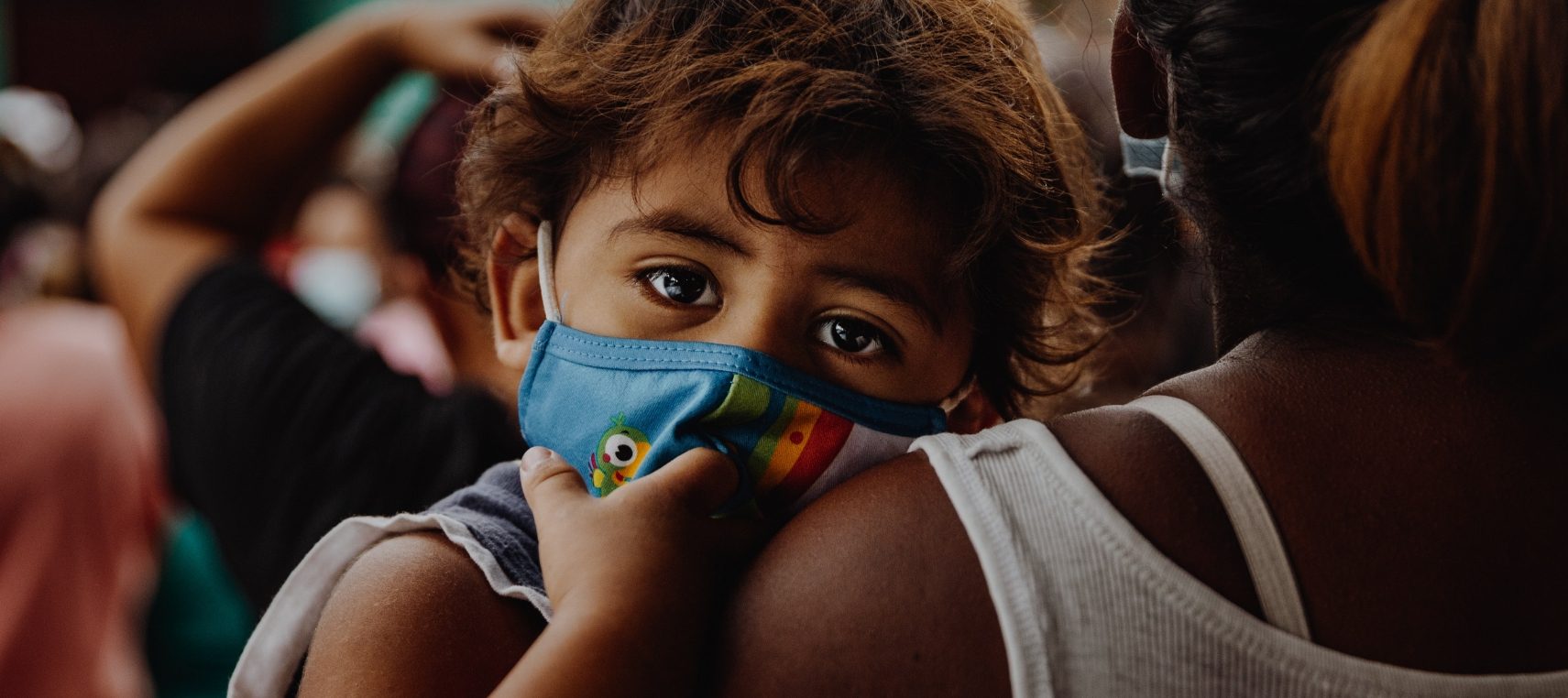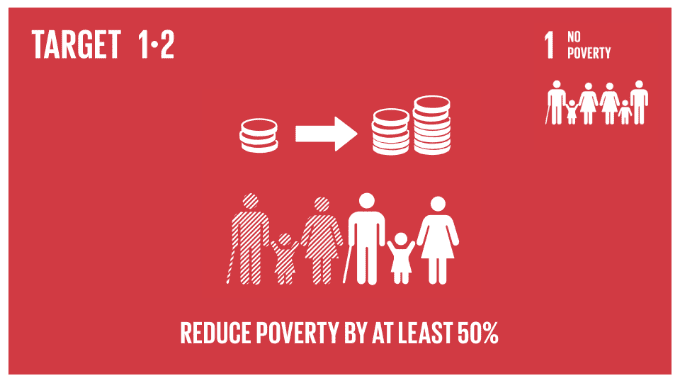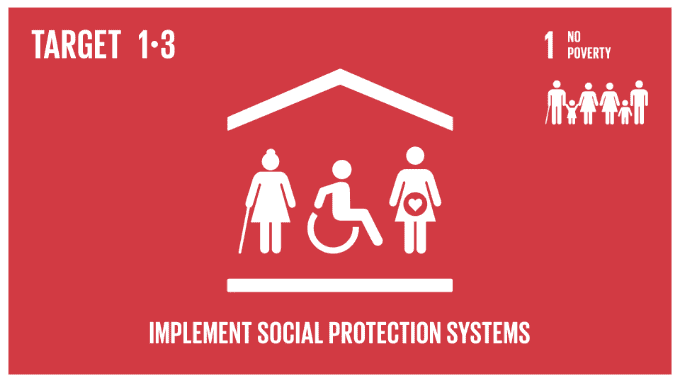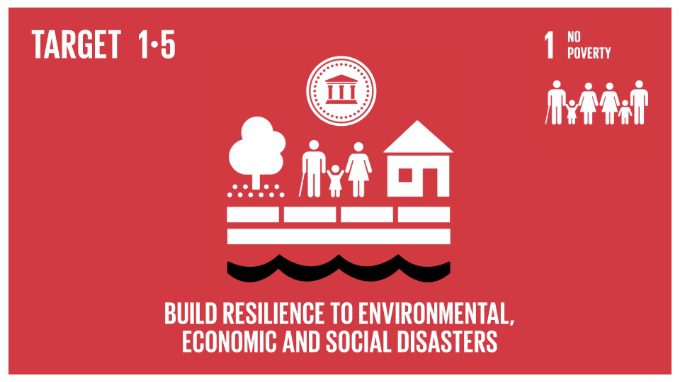Overview:
Eradicating poverty is not a task of charity, it’s an act of justice and the key to unlocking human potential. Still, nearly half of the world’s population lives in poverty, and lack of food and clean water is killing thousands every single day of the year. Together, we can feed the hungry, wipe out disease and give everyone in the world a chance to prosper and live a productive and rich life.

International Progress 2023:
Since 2015, global poverty reduction was already slowing down and the impacts of the COVID-19 pandemic reversed three decades of steady progress with the number of people living in extreme poverty increasing for the first time in a generation. Recovery from the pandemic has been slow and uneven as the world is presently facing multiple geopolitical, socioeconomic, and climatic risks. Given current trends, 575 million people (nearly 7% of the world’s population) will still be living in extreme poverty in 2030 compared to 800 million in 2015 (or 10.8%).
Eradicating extreme poverty will be particularly difficult in sub-Saharan Africa and conflict-affected areas. Despite the expansion of social protection during COVID-19, over 4 billion people globally remain entirely unprotected. A surge in action and investment to enhance job opportunities and extend social services to the most excluded is crucial to delivering on the central commitment to ending poverty.
Targets —
-

Target 1.1
Since 2019, 70 million more people were pushed back into extreme poverty – currently defined as those who live on less than $2.15 per person per day at 2017 purchasing power parity. The rate increased from 8.5% in 2019 to 9.3% in 2020. By the end of 2022, nowcasting suggests 8.4% of the world population or as many as 670 million people could still be living in extreme poverty today and that the figure will drop to 575 million by 2030 – a fall of less than 30% since 2015.
-

Target 1.2
Given historical trends, only one-third of countries will have halved their national poverty rates by 2030 from 2015.
-

Target 1.3
By 2020, only 47% of the global population was effectively covered by at least one social protection cash benefit, slightly improved from 45% in 2015. Only 26% of children under 15 received a social protection benefit; only one in three persons with severe disabilities worldwide receive a disability benefit; only 35% of workers are covered in case of work injury; and only 18.6% of unemployed workers worldwide are effectively covered.
-

Target 1.4
Shifting public resources towards essential services is one of the key policy interventions for reducing poverty and building a better social safety net. The 2021 data for 100 countries shows that the global average proportion of total government spending on essential services is approximately 53%, with an overall average of 62% for advanced economies and 44% for emerging market and developing economies.
Ireland’s
Progress 2023:
Ireland’s poverty target, adopted in the Roadmap for Social Inclusion 2020-2025 is to reduce consistent poverty to 2% or less by 2025. The Central Statistic Office and the Irish Government claim that Ireland is achieving all of its targets on SDG 1: No Poverty, as laid out in its SDG Traffic-Light Assessment.
The 2022 Survey on Income and Living Conditions (SILC) highlights the level of poverty among different groups in society with some experiencing higher levels of poverty than the general population. This includes those who are unemployed, lone parent households, people unable to work due to long-standing health problems, households with one adult under 65 years, with no-one at work and where someone is renting or living rent free. A significant change from previous years was the increase in poverty for those living alone who are 65 years and over. The SILC does not include the poverty levels among groups such as Travellers, Roma, migrants, and other ethnic minorities or those who are homeless, and it cannot tell us what the impact of poverty has on people or communities, including disadvantaged socio-economic communities. Source: EAPN Ireland
Targets —
-

By 2030, eradicate extreme poverty for all people everywhere, currently measured as people living on less than $1.25 a day.
CSO data
Claim: Achieving
The consistent poverty rate in Ireland fell from 7% in 2005 to 4.2% by 2008 before rising to 9% in 2013. Over the following five years, the rate fell to 5.6% in 2018.
Measuring what matters
The consistent poverty rate in SILC 2022 was 5.3% or one in twenty of the population, up from 4% in 2021. This is over 271,500 people. The consistent poverty rate was highest among persons unable to work due to long-standing health problems (19.7%) and the unemployed (18.0%). The consistent poverty rate for those living in owner-occupied dwellings was 2.2% compared with 12.9% for those living in rented or rent-free accommodation. While less than 30% of the population are living in rented or rent-free accommodation, such people make up over 70% of those living in consistent poverty. Source: SILC 2022
1.1.1
Proportion of the population living below the international poverty line by sex, age, employment status and geographic location (urban/rural)
-

By 2030, reduce at least by half the proportion of men, women and children of all ages living in poverty in all its dimensions according to national definitions.
CSO data
Claim: Achieving
The at risk of poverty rate fell from 19.4% in 2004 to 14.1% in 2009, before increasing to 16.7% in 2014. The rate then fell over the following four years to stand at 14% in 2018.
By no metric is this a reduction in half as per target 1.2. They also do not disaggregate by sex and age as per indicators 1.2.1 and 1.2.2
Measuring what matters
In 2022, 13.1% of the population or 671,000 people were living below the poverty line (or were at risk of poverty) as they had an income that was less than 60% of the median disposable income, so €15,754 per annum or €301.91 per week. In terms of women: 13.2% were at risk of poverty, 19.1% were in enforced deprivation, 5.7% were in consistent poverty. For children: 15.2% were at risk of poverty, 19.9% were in enforced deprivation, and 7.5% were in consistent poverty.
In SILC 2022, 17.7% of the population or over 906,500 people were defined as living in enforced deprivation, i.e. cannot afford two or more of the eleven items considered essential. This compares with 13.8% in 2021. 9.5% were unable to afford new clothes (not second-hand) in 2022, up from 8.9% in 2021. 9.7% were unable to afford a morning, afternoon or evening out in last fortnight in 2022, up from 3.8% in 2021 7.2% were unable to afford to keep the home adequately warm in 2022, up from 3.2% in 2021. 1.4% were unable to afford a meal with meat, chicken or fish (or vegetarian equivalent) every second day in 2022 down from 1.6% in 2021 compared with 13.8% in 2021. Almost half (48.6%) of those who are unemployed were in deprivation as were 44.3% of those who were unable to work due to long-standing health problems and 43.5% of lone parent households.
The consistent poverty measure is defined as people who are both at risk of poverty and experiencing enforced deprivation. The consistent poverty rate in SILC 2022 was 5.3% or one in twenty of the population, up from 4% in 2021. This is over 271,500 people. The consistent poverty rate was highest among persons unable to work due to long-standing health problems (19.7%) and the unemployed (18.0%). The consistent poverty rate for those living in owner-occupied dwellings was 2.2% compared with 12.9% for those living in rented or rent-free accommodation. While less than 30% of the population are living in rented or rent-free accommodation, such people make up over 70% of those living in consistent poverty.
By age group, the largest year on year change in the at risk of poverty rate was in persons ages 65 or over, going from 11.9% in 2021 to 19.0% in 2022. The at risk of poverty rate for individuals in households with one adult and one or more children aged under 18 (one parent families) was 23.8%, compared with 13.1% of persons living in two adult households with 1-3 children.
Source: Survey on Income and Living Conditions (SILC) 2022
By no metric is this a reduction in half as per target 1.2
1.2.1
Proportion of population living below the national poverty line, by sex and age
1.2.2
Proportion of men, women and children of all ages living in poverty in all its dimensions according to national definitions
-

Implement nationally appropriate social protection systems and measures for all, including floors, and by 2030 achieve substantial coverage of the poor and the vulnerable.
CSO data
Claim: Achieving
A state pension was received by over one in eleven people in Ireland in 2019. The non-contributory state pension was received by 2% of people while over four times as many people received the contributory state pension, at 9.1% of the population in 2019. Jobseekers Allowance and Benefits were received by almost 3% of people in 2019.
They do not disaggregate by sex, distinguishing children, unemployed persons, older persons, persons with disabilities, pregnant women, newborns, work injury victims, and the poor and the vulnerable as per indicator 1.3.1.
1.3.1
Proportion of population covered by social protection floors/systems, by sex, distinguishing children, unemployed persons, older persons, persons with disabilities, pregnant women, newborns, work injury victims, and the poor and the vulnerable.
-

By 2030, eradicate extreme poverty for all people everywhere, currently measured as people living on less than $1.25 a day.
CSO data
Claim: Achieving
Indicator 1.4.1 According to the Census of Population only 1.4% of people had no central heating in 2016. One in a 1,000 people lived in a household without a piped water supply. There was no sewerage facility available for one in every 1,000 people in 2016. Three out of every 1,000 people lived in a mobile home or temporary structure.
Indicator 1.4.2 Census of Population 2016 results show that nearly seven out of ten people (69%) had secure tenure rights to land in 2016. In this context secure tenure rights to land are defined as owner-occupiers in the Census 2016 data. Note that this definition excludes renters who and their security of tenure.
1.4.1
Proportion of population living in households with access to basic services.
1.4.2
Proportion of total adult population with secure tenure rights to land, (a) with legally recognised documentation, and (b) who perceive their rights to land as secure, by sex and type of tenure.
-

By 2030, build the resilience of the poor and those in vulnerable situations and reduce their exposure and vulnerability to climate-related extreme events and other economic, social and environmental shocks and disasters.
CSO data
Claim: Achieving
Indicator 1.5.1 Persons Attributed to Disasters and The Direct Economic Loss Attributed to Disasters are Tier 2 UN-SDG Indicators and currently not reported at national level.
Indicator 1.5.2 No data from CSO.
Indicator 1.5.3 On the 19th of January 2018 The Minister for Communications, Climate Action and Environment published Ireland’s first statutory National Adaptation Framework and announced funding of €10m to establish Local Authority Regional Climate Action Offices, The National Adaptation Framework (NAF) sets out the national strategy to reduce the vulnerability of the country to the negative effects of climate change and to avail of positive impacts. The Sendai Framework data readiness review report (Preliminary Report) reviews the availability of data in Ireland to report against the indicators recommended to measure the global targets of the Sendai Framework, and identify current gaps.
Indicator 1.5.4 Social Inclusion and Community Activation Programme (SICAP) aims to tackle poverty and social exclusion at a local level. The funding for SICAP was €37.5 million in both 2016 and 2017 and rose to €38 million in 2018. The Community Enhancement Programme (CEP) enhances facilities in disadvantaged areas. For more details see the Background Notes. There was €13 million allocated to CEP in 2018. Note this answer is not related to the indicator. No data on the indicator is actually provided.
1.5.1
Number of deaths, missing persons and directly affected persons attributed to disasters per 100,000 population.
1.5.2
Direct disaster economic loss in relation to global gross domestic product (GDP)
1.5.3
Number of countries that adopt and implement national disaster risk reduction strategies in line with the Sendai Framework for Disaster Risk Reduction 2015–2030.
1.5.4
Proportion of local governments that adopt and implement local disaster risk reduction strategies in line with national disaster risk reduction strategies.
-

Ensure significant mobilization of resources from a variety of sources, including through enhanced development cooperation, in order to provide adequate and predictable means for developing countries, in particular least developed countries, to implement programmes and policies to end poverty in all its dimensions.
CSO data
Claim: Achieving
Indicator 1.a.1 Total Official Development Assistance amounted to €791.6 million in 2018, up from the 2017 figure of €743.4 million. As a % of GNP, ODA rose from 0.3% in 2000 to 0.59% in 2008 before dropping to 0.3% in 2018. Note this does not provide the data requested by the indicator.
Indicator 1.a.2 Total Government expenditure rose from €26.1 billion in 2000 to €63.1 billion in 2009 before dropping to €54.1 billion in 2014. Expenditure increased again over the following years before dropping slightly to €59 billion in 2019. It is estimated that total government expenditure will be €61.9 billion in 2020. See Table 4.2. Social Protection is estimated to account for 34.1% of total expenditure in 2020, with 28.1% going to Health and 16.5% to Education. This contradicts target 16.6.2 which shows that there are issues around satisfaction with health care in Ireland.
1.a.1
Total official development assistance grants from all donors that focus on poverty reduction as a share of the recipient country’s gross national income.
1.a.2
Proportion of total government spending on essential services (education, health and social protection)
-

Create sound policy frameworks at the national, regional and international levels, based on pro-poor and gender sensitive development strategies, to support accelerated investment in poverty eradication actions.
CSO data
Claim: Achieving
The Development Assistance Committee of the OECD (DAC) that 80% of Ireland’s ODA is gender sensitive, and 13% has gender as the principal objective. Both figures are among the highest in the OECD.
1.b.1
Proportion of government recurrent and capital spending to sectors that disproportionately benefit women, the poor and vulnerable groups.









